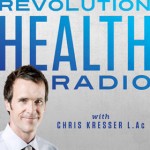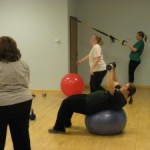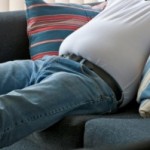

In this episode we talk about a really interesting study that came across my desk on the saturated fat – heart disease myth. I also revisit the colonoscopy question we had in a previous episode and take questions from Facebook.In this episode, we cover:3:55 New Study: is the saturated fat – heart disease myth finally dead?18:18 The health risks associated with colonoscopies29:12 Managing histamine intolerance34:40 Chris answers: “What is health?”44:00 Does intermittent fasting harm the adrenals?51:30 Chris Answers: “What is your workout routine?”Links We Discuss:Use of dietary linoleic acid for secondary prevention of coronary heart disease and death: evaluation of recovered data from the Sydney Diet Heart Study and updated meta-analysis The Roar of the Wolverine Blog Podcast: Play in new window | Download Full Text Transcript:Steve Wright: Hi and welcome to another episode of the Revolution Health Radio Show. This show is brought to you by ChrisKresser.com. I’m your host, Steve Wright, and you can find my work at SCDLifestyle.com, but we’re both here to learn from integrative medical practitioner and healthy skeptic Chris Kresser, so Chris, how’s your day going?Chris Kresser: My day is going great. It’s a sunny, clear, beautiful day here in February in California. Can’t complain. How are you?Steve Wright: My day is good as well. You know what? We actually have a clear, sunny day in Michigan as well!Chris Kresser: Fabulous. Well, I’m excited. I posted a little request for questions on Facebook yesterday and was surprised to get 194 of them in less than 12 hours, so we better hurry up if we’re going to get to all those questions today, Steve.Steve Wright: Yeah, I was trying to take some classes on speed-reading and speed-talking, but I don’t know if we’re going to do it, Chris.Chris Kresser: Haha. But we have enough for a couple years now on the show, so that’s good news. There were some great questions, actually. It was hard to pick some, and of course, we have a backlog of some from the podcast submission form as well. So, I think we’re good for a little while.Steve Wright: Yeah, we’re definitely good until at least 2014, but we would still appreciate more questions.Chris Kresser: Yeah. It’s fun to get fresh questions. That’s why I like posting to Facebook to see what people are thinking about right now, and the other cool thing about Facebook is other people will like questions that they have as well, so then we can kind of get a sense of which questions are most relevant to people that are listening to the show. So, go social media!Steve Wright: Yes, go social media! And if you want to follow Chris and where all this action took place, head over to Facebook.com/ChrisKresserLAc. And we didn’t solicit Twitter that I know of, but if you want to follow Chris on Twitter, it’s Twitter.com/ChrisKresser.Chris Kresser: Yeah, well, maybe next time we’ll just do Twitter and get the Twitter crowd.Steve Wright: Yeah, we could do a tweet-a-thon question thingamabob.Chris Kresser: Haha, all right. So, are you ready to dive in Steve? Shall we do it?Steve Wright: I am but most importantly I need you to make sure you’re fresh because 194 questions — you better have your voice with you, so get some water, some tea, some coffee, all of those things above, and I want to tell everyone about Beyond Paleo. So, if you’re new to listening to the Revolution Health Radio Show, if you’re new to the paleo diet, or you’re just interested in optimizing your health, you’re going to want to check out what over 10,000 other people already have signed up for. It’s a free 13-part email series that Chris has put together called Beyond Paleo, and like I said, it’s 13 emails that Chris has put together on tips and tricks for burning fat, boosting energy, and preventing and reversing disease without drugs. Now, if this is something you’re interested in, head over to ChrisKresser.com, look for the giant red box in the middle of the page, and go ahead and put your name and email in there and get on the list.OK, Chris, how’s the voice?New Study: is the saturated fat – heart disease myth finally dead?Chris Kresser: It’s pretty good, pretty good. So, I’m going to talk about a really interesting study that just came across my desk today, so to speak, and I want to revisit the colonoscopy question that we had. I said I would come back to that after doing a little more research. This isn’t going to be the conclusive answer on the subject, and I don’t know that there is one actually, but I’ll talk a little bit more about that, and then we’ll get into some questions.Steve Wright: OK, perfect! So, what is the study?Chris Kresser: This was a study about omega-6 and saturated fat and their respective relationships to heart disease. More specifically actually, what the researchers did — This was Christopher Ramsden, his group. He has done a lot of the studies on linoleic acid, omega-6 polyunsaturated fat, and heart disease. And what they did is they went back and resurrected some data from the Sydney Diet Heart Study, which was done in the 1960s, and reanalyzed it using modern statistical methods. Some of the data from that study wasn’t published in the original reporting of that study, and so they went back and looked at the raw data and then reanalyzed it.You know, one of the cornerstones of the advice given for heart disease, at least in the mainstream paradigm, is to replace saturated fat with polyunsaturated oils, so soybean oil and corn oil and safflower and sunflower oil. I think that’s changing a little bit now. In fact, I think the most current guidelines don’t suggest those oils. They talk more about the monounsaturated oils, like olive oil and stuff like that, but still there are a lot of people out there who were listening for those 20 or 30 years that the mainstream health organizations were telling people not to eat saturated fat and to eat margarine and corn oil instead. And when this advice originated back in the ’60s, polyunsaturated fat and omega-6 were used interchangeably as terms because at that time, they only really knew about linoleic acid. They didn’t know about the omega-3 fats yet. And so, a lot of the early studies that suggested that polyunsaturated fat or omega-6 were beneficial also included omega-3?s because they didn’t know enough to separate them out. Of course, we now know that omega-3?s have really different properties than omega-6, and when you actually look at studies that separate linoleic acid, which is the main short-chain, plant-based form of omega-6 fat, from the omega-3?s, there’s really no evidence that replacing saturated fat with linoleic acid lowers heart disease risk, and there’s some evidence that it might even increase it, which this study contributes to.So, as I mentioned, this paper resurrected data from the Sydney Diet Heart Study. It was a randomized, single-blind trial from 1966 to 1973, and it’s a pretty unusual opportunity to study the effects of linoleic acid because they used safflower oil, which is 75% linoleic acid by weight, so if you have 100 g of safflower oil, 75 g of that is going to be linoleic acid. And there are no other polyunsaturated fats in safflower oil, so you don’t run into the problems that we have in other studies where you have multiple polyunsaturated fats and you can’t tell which one is having which effect. So, the participants were men between 30 and 59 years old who had recently had a heart attack or an acute episode of angina, and there were 221 men in the intervention group and 237 in the control group, and the intervention group was told to increase their linoleic acid or total polyunsaturated fat intake to 15% and to decrease saturated fat and cholesterol to below 10% per day.And a really important point about this study is that some people in the control group went ahead and decreased their saturated fat intake and increased their linoleic acid anyhow after their heart attack on their own. They weren’t told to do that by the study investigators, but they had heard enough maybe through the media or whatever and they had recently had a heart attack and they thought maybe it was the butter or something, and so they did that on their own. So, this study was not a perfect — as observational studies rarely are — it wasn’t a perfect separation between people who were following these guidelines and people who weren’t, and what that means is that the difference that was observed between the two groups could have been even greater if the control group was strictly just eating animal fats rather than vegetable oil or a combination of vegetable oil and animal fats.So, what the researchers did is they provided the participants in the trial with safflower oil and safflower oil margarine — mmm, yum — and then they also gave them safflower oil to take in capsules as a supplement.Steve Wright: Oh, wow.Chris Kresser: Yeah. So, it was a little different than just a completely free-living study where they gave instructions and then just left it up to the participants to do whatever they were going to do. They actually provided the safflower oil and the margarine for them to use as fats to put on their toast and use in salad dressing and things like that, and then they also gave them safflower oil in capsules, so definitely not like a metabolic ward study where people were living in the hospital while they were doing this, but it was a little bit better than a typical free-living study. And then the food frequency questionnaires were every seven days, which is really much more frequent than they typically are in these longer-term studies. You still have some of the problems of people not being able to remember what they ate, but those should be a little bit less with seven-day questionnaires rather than people being asked to remember what they ate six months or a year ago.In this study, because of the way it was designed and using safflower oil, which is pretty much mostly linoleic acid with no other PUFA, they were able to selectively increase linoleic acid levels without also increasing omega-3 levels. So, what were the results? The intervention group, the people who had the safflower oil and decreased saturated fat, had an increased risk of death from all causes, 17.6% versus 11.8% in the control group; they had an increase in death from cardiovascular disease, 17.2% versus 11%; and then an increase in deaths from heart disease, 16.3% versus 10.1%. And the researchers calculated that an increase of 5% of calories from linoleic acid predicted a 35% increase in deaths from cardiovascular disease and a 29% increase in deaths from all causes.Another important thing about this study is that the intervention group that had a statistically significantly higher risk of death had lower cholesterol levels than the control group. So, linoleic acid did indeed reduce their cholesterol levels, but they were more likely to die, and that’s really important to get because some of the studies that suggest that omega-6 linoleic acid improves heart disease risk didn’t even have mortality as an endpoint. All they did was look at people’s cholesterol levels, and if the cholesterol levels went down, in the conclusion of the study they’d say: Oh, it reduces the risk of heart disease because everybody knows that when your cholesterol levels go down, your risk of heart disease goes down as well. Of course, we know that there are studies that actually show the opposite and that the concentration of cholesterol inside of the lipoprotein is not the main driving risk factor for heart disease, but there’s this whole group-think thing that happens, and in the studies they don’t even bother sometimes to cite a reference for that when they make that claim. It’s just so deeply ingrained that they figure they don’t even need to cite a reference for it. So, yeah, the cholesterol levels went down, but people still died more frequently in the group that was eating more linoleic acid.And the researchers went on to speculate a little bit about the mechanisms. The theory is that omega-6 fats are — and this isn’t so much a theory. This is pretty well established that they’re very fragile and vulnerable to oxidative damage. And studies have shown that oxidized metabolites of linoleic acid, which are referred to as OXLAMs, are the most abundant oxidized fats in oxidized LDL particles. So in other words, when LDL oxidizes, it’s usually the linoleic acid in the LDL particle that oxidizes, and this is important because oxidized LDL is potentially much more atherogenic than normal or native unoxidized LDL because it stimulates collagen formation, which forms the fibrous plaque. It weakens plaque stability, which makes plaque more likely to rupture, and that’s the precipitating event for a heart attack. Oxidized LDL is smaller and denser than native LDL, which makes it more likely to penetrate the fragile lining of the artery, and that’s what initiates the process of plaque formation. So, when you put all those together, it might explain why some recent trials have shown that if you look at omega-6 individually in studies where they isolated the effects of linoleic acid from other polyunsaturated fats that it increases the amount of these OXLAMs, these oxidized metabolites of linoleic acid, and possibly increases the risk of heart disease because of that.And then there was another study recently that showed that lowering linoleic acid in the diet reduced levels of OXLAMs and their precursors and then increased levels of EPA and DHA. So, it’s just another study to add to the pile of research that we already have that suggests that we should base our diet on traditional fats that human beings have been eating for a very, very long time that we get naturally from eating animal products, long-chain saturated fats, medium-chain triglycerides, and omega-3 long-chain fats DHA and EPA from eating cold-water fatty fish are particularly important. And then a low to moderate amount of omega-6 linoleic acid as it naturally occurs in things like nuts and avocados and poultry is fine, but this idea that we should be dramatically reducing our saturated fat intake and increasing our intake of vegetable oils to protect against heart disease really just has no support for it in the scientific literature.Steve Wright: Well, I can’t say that I’m surprised, Chris.Chris Kresser: No.Steve Wright: But I will try to add to the conversation. I think something that is still kind of confusing to some people in the health sphere that we work in is this idea that some of the higher-level fats can actually convert into EPA and DHA. Can any of the linoleic acid actually convert into EPA or DHA?Chris Kresser: No, those are different pathways. You have conversion and retroconversion in both pathways. For example, some of the longest-chain omega-3?s can retroconvert to EPA, which is a long chain but it’s not the longest, so you can go backwards in the conversion process in some circumstances. And the main conversion process that happens is from the short-chain fats to the longest-chains. So, alpha-linolenic acid is the short-chain omega-3, and that has to go through several steps to get to EPA, and then further down the line is DHA. And I think I mentioned this before, but less than half a percent of alpha-linolenic acid, the plant-based omega-3 that’s found in flax and walnut, gets converted into DHA, which is probably the most beneficial long-chain omega-3 fat. Something like 5% gets converted into EPA. But that’s in healthy people, and the enzymes that are required to make those conversions are dependent on B6 and zinc and other micronutrients that a lot of people are deficient in, especially vegetarians and vegans who need that conversion to be more efficient because they’re only eating the shorter-chain fats, so there’s kind of a cruel irony there, where they’re more likely to be deficient in the nutrients that are needed to make those conversions, and the conversion is already so poor, even in people who have sufficient amounts of those nutrients. And then the other thing where the relationship is, is that omega-6 can compete for some of the conversion enzymes, and so if you have an excess of omega-6 in your diet, that’s going to impair your conversion of short-chain omega-3 to the EPA and DHA. That can be mitigated to some extent by just eating EPA and DHA, so you don’t need to worry about the conversion as much, but particularly for people who aren’t eating those longer-chain fats, it’s really problematic if they have a diet that’s high in omega-6.Steve Wright: And that’s why you recommend eating fish several times a week, correct?Chris Kresser: That’s right.The health risks associated with colonoscopiesSteve Wright: All right. So, shall we move on to the dirty subject of colonoscopies?Chris Kresser: Yeah, let’s do that. One of my listeners, Tucker, forwarded me an article about this subject, I think after he had heard us talk about this on the last podcast, and it was an article on a blog called the Roar of Wolverine, which is a pretty cool name for a blog if you ask me! I don’t know the person who writes this blog. He has a really fascinating story that’s relevant to the topic we’re discussing here, which I’ll get into in a second, but in this article about colonoscopy, he linked to study suggesting that colonoscopies may cause more deaths than they prevent, and this is something I touched on when we were talking about this originally. In a lot of these screening procedures, that’s part of the issue is if the procedure itself is dangerous and it causes more deaths than it prevents, that’s obviously not very smart. But sometimes even when the procedure itself is not dangerous, it can lead to overtreatment and the treatment can be dangerous, and then that can end up causing more harm than the thing that the screening procedure is designed to prevent in the first place.This study suggested that the perforation rate — This is one of the main risks of a colonoscopy is you’re inserting a scope, a solid object, into the colon, which is a soft tissue, and one of the dangers of doing that is poking a hole in the intestine. And the perforation rate apparently is 1 in 1000 procedures, which might not sound like a lot, but when you compare it to the rates of colorectal cancer, it’s fairly significant. And then there are serious complications in 5 out of every 1000 colonoscopies.Again, just to kind of put this in perspective, 999 people will get a colonoscopy and not have a perforation, and 995 people will have a colonoscopy and not have a serious complication, so overwhelmingly the odds are in favor of nothing serious happening if you have a colonoscopy. I just want to point that out. But there are a few reasons to believe that the numbers might even be higher. For one — and this is the case in a lot of different situations, like with side effects of statin drugs — in any adverse effects, they tend to be underreported because the reporting system just isn’t that robust and it’s dependent on the doctor actually making the report and the patient and/or the doctor realizing that the problem is related to the procedure and just having time to fill out the paperwork and all that stuff, so it generally means reactions and complications tend to be underreported rather than overreported.And then there are some other risks associated with colonoscopies, including infection. It has recently been revealed that it’s impossible to completely sterilize an endoscope — there was actually an article in the LA Times about this awhile back — because the endoscopes have these cavities that are inaccessible to being cleaned completely by hand. And then another problem is that one of the common sterilizers they use for colonoscopies, which is called glutaraldehyde, has actually been shown to cause colitis itself. This might explain why some people actually develop colitis after having a colonoscopy.We talked last time about the washout procedure that you have to do before the colonoscopy that removes a lot of the beneficial bacteria in the gut, which could definitely be problematic. And then there are more rare reactions that can happen, like to general anesthesia. A colonoscopy, I think, is the only cancer screening test that requires you to go under general to have it, and general anesthesia definitely can cause some problems for some people — deep vein thrombosis, pulmonary embolism, kidney damage, electrolyte imbalance, and a few other not-so-nice things. Those are very rare, but since we’re talking about the risk, it’s worth pointing out.There was another study in the Annals of Internal Medicine that showed that 70,000 or 0.5% of people who get colonoscopies are either injured or killed by complications related to the procedure. And that figure is 22% higher than annual deaths from colorectal cancer. So again, when you think about it, if the procedure is causing more injuries and deaths than what it’s screening against, you really want to think twice about whether you’re going to do it. And that’s on a population-wide scale. Part of the problem when talk about these studies is that studies are looking at populations, but when we’re talking about whether to get a test or do a treatment, we’re really talking about individuals, and individuals have medical histories and different risk tolerances and different circumstances and situations that need to be taken into account. So, if someone is at very high risk for colorectal cancer, for example, it runs in their family and they have a number of other lifestyle risk factors, then it very well may make sense for that person to get a colonoscopy in spite of these statistics. The statistics are just averages, but we don’t treat averages in a clinic, we treat people, so you just have to keep that in mind when we’re talking about things like this.Another thing is the average age for the onset for colorectal cancer is, I think, 71, and typically the mainstream recommendation is to start screening at 50 years old and 45 for African Americans. So, the first couple of decades there, based on these statistics, it would seem that getting a colonoscopy might be more risky than it’s worth, depending on your personal situation. But perhaps as time passes, those odds start to even out a little bit. It’s still a little unclear to me.There was a study — just to present the other side of the argument — also in the Annals of Internal Medicine that looked at 10,300 patients who had died of colorectal cancer, and then they looked at five matched controls for each patient who died, so over 50,000 controls. Seven percent of patients who died had not had a colonoscopy in the previous time leading up to study versus 9.8% of controls, so not a huge difference, but it was statistically significant. And interestingly, the difference was only valid for cancer of the right colon, not the left.So, this guy’s story who writes that blog is pretty interesting. At 48, he developed colitis, and he went in to have a colonoscopy, and he suffered a perforation during the colonoscopy and developed a really serious infection and went through hell, it looks like. His story is on his blog; you can check it out. But he eventually had emergency surgery where they discovered his intestines were necrotic, so the tissue had died. They removed all by 3 feet of his small intestine, and then after more surgeries, he ended up with just 10 inches of small intestine left, which is barely enough to live on. And then he finally ended up receiving a full intestinal transplant, which is a really rare procedure. And after he had that transplant, he had to receive regular colonoscopies to check up, and after one of them, he contracted an infection with a gram-negative bacteria pseudomonas species, which can be really, really serious in immunocompromised patients like him, and that almost finished him. His blood pressured dropped to 35/28, and he was given a really small chance of surviving and basically told to say goodbye to his wife. This is obviously a really extreme story on the spectrum. Most people, as I said, get colonoscopies and don’t experience anything like this, but it is important to at least understand the risks when you’re considering a procedure like this so you can determine whether it makes sense for you to do it.Steve Wright: Yeah, it sure is one of those kind of catch-22 scenarios because it definitely seems to do some good, but the risks are definitely there. I mean, we hear about them on our site quite often with people who have some sort of inflammatory bowel disease and they’re in basically what they believe to be is remission. — Remission is kind of an interesting term. It’s kind of like ‘cure.’ You don’t really know what that is.
Continue reading here:
RHR: The saturated fat – heart disease myth, colonoscopy health …















 For now classes are 6pm and 640pm at 2840 Wildwood st in the Boise Cloggers studio.
Book your class NOW!
click this ==>
For now classes are 6pm and 640pm at 2840 Wildwood st in the Boise Cloggers studio.
Book your class NOW!
click this ==>








